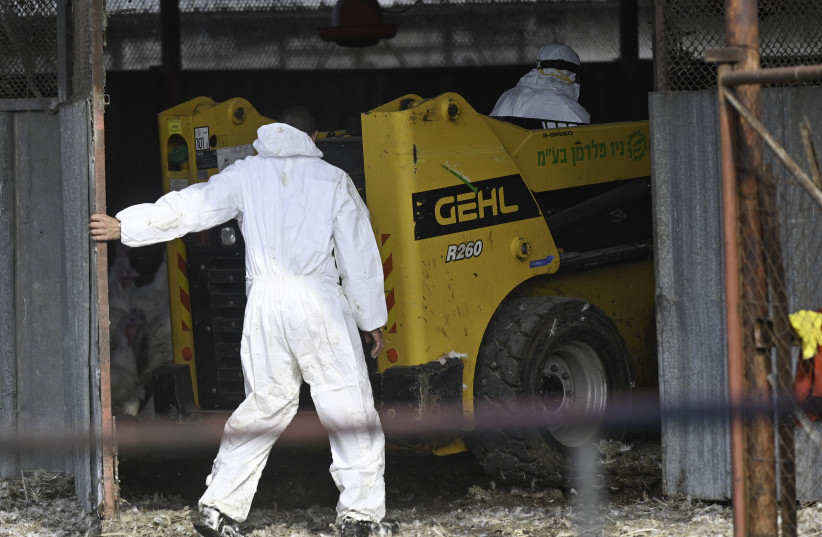Geese and swans are some of the main factors in spreading Eurasian H5 Highly Pathogenic Avian Influenza (HPAI) a new study has found, as North America suffers from one of the worst bird flu outbreaks ever observed on the continent.
Researchers from the Cummings School of Veterinary Medicine at Tufts University realized that in order to understand how avian influenza spread, scientists would need to take a deeper lock into how the flu spread through individual species.
While historically, ducks have been considered the main spreaders of avian influenza, the new study, published in the peer-reviewed PLOS Pathogens on Thursday, found that geese and swans were underrated carriers of the virus.
“When we looked at which birds were responsible for spillover into poultry, signs pointed to wild geese, which are really good at amplifying the virus,” said Nichola Hill, lead author of the paper and an assistant professor of biology at the University of Massachusetts Boston and Tufts University. “We need to understand why in terms of their host pathology, immunity, behavior, and ecology.”
One factor which may make geese an effective spreader of the virus is the fact that geese are land grazers and thrive in both cities and agricultural settings. "They really are the perfect spillover host because they can make use of human-altered habitat," said Hill.

Understanding which birds drive the long-distance spread of avian influenza may help researchers figure out how the virus enters new geographic regions. While the 2014 outbreak of avian influenza in North America arrived over the Pacific Ocean, the latest outbreak hitting the US and Canada came from over the Atlantic.
According to Tufts Now, the first wild bird detections of avian influenza in 2021 were great black-backed gulls. “Gulls are strong, long-distance, pelagic fliers that take advantage of tailwinds to travel over the ocean and move the virus very quickly," said Hill.
The latest outbreak in North America is the largest ever recorded on the continent, with about 40 species of birds infected over a large area.
“Knowing that gulls, geese and ducks may be moving this virus in different ways is a big contribution to understanding or eventually modeling with more accuracy how we expect a virus like this to spread,” said Jonathan Runstadler, professor and chair of the Department of Infectious Disease & Global Health at Cummings, to Tufts Now.
“Ultimately, we could put this data into a model that allows us to predict if there's a virus emerging, when that virus might enter North America, and what bird populations we might target for surveillance to detect it,” he added.
While only one human case of bird flu has been recorded in the current outbreak in the US and that case was mild, Hill stressed that the fact that the symptoms were mild is concerning as it could make detection and tracking harder because infected individuals may ignore their symptoms.
Hill is also concerned with spillover to other mammals, as the virus is able to spread to other animals and infections have recently been recorded in red foxes and skunks.
With nearly 38 million domestic birds and many other wild birds estimated to have been affected by the latest bird flu outbreak, Runstadler stated that "nobody knows" when the outbreak will end as "we don't have a sophisticated enough understanding though we hope someday we will. It's a very complex system.”
Bird flu is 'here to stay'
While the outbreak in 2014 did eventually fade away, Runstadler stressed that this is unlikely to happen this time due to the different characteristics of the current outbreak. “There's reason to expect this virus is here to stay, and it's not going to disappear."
According to the Animal and Plant Health Inspection Service of the US Department of Agriculture, bird flu infections have been recorded in domestic flocks in 35 states. Infections in wild birds have been detected in additional states.
Alongside supply chain cost increases and shortages of feed and grains, the outbreak has been a factor in causing egg prices to soar, with prices spiking about 22% in Europe and 44% in the US in the past year, according to the World Organization for Animal Health (OIE).
From October 2021 to May 2022, over 21 million cases of bird flu in poultry were reported to the OIE throughout the world. When bird flu affects a flock, the flock, including both healthy and infected birds, is usually culled in order to stop the spread of the virus. In the US, 25 million egg-laying hens have been lost due to the outbreak, reducing egg production in the country by 8%.
The OIE added that other products, such as poultry meat, are also expected to rise in costs soon due to the same reasons.
In Canada, bird flu was detected for the first time in skunks. The virus has been detected in red foxes in the country as well. Dr. Margo Pybus told CTV News Edmonton that the latest strain of the virus is "hotter than usual" as "This is the first time we've seen mortality in wild birds, and it's also the first time we've seen mortality in mammals that are eating the wild birds."
In line with the study from Tufts University, Pybus mentioned that outbreaks in other locations tended to fall off once geese left the area.
While the risk to the general public's health is considered low, some people who have job-related or recreational exposure to birds may have a higher risk of infection. The CDC stated that it "is watching this situation closely and taking routine preparedness and prevention measures in case this virus changes to pose a greater human health risk."
